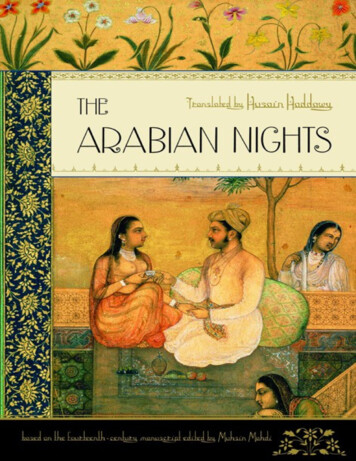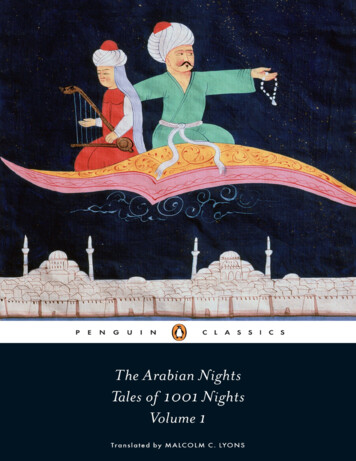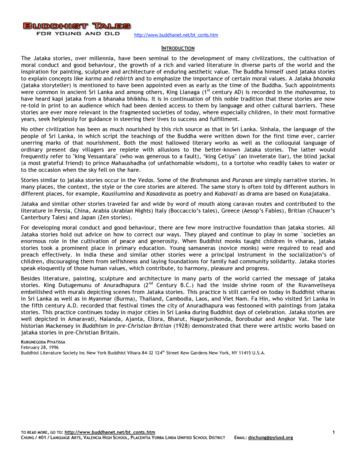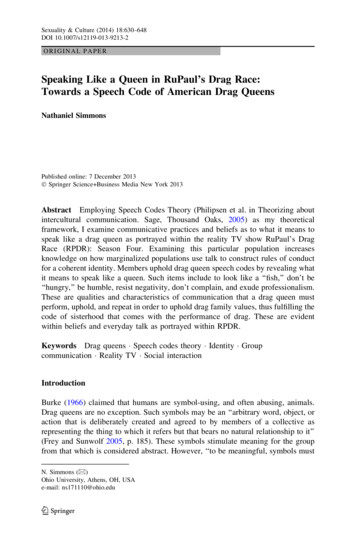
Transcription
TheArabianNightsTRANSLATED BYHusain HaddawyBASED ON THE TEXT OF THEFOURTEENTH-CENTURY SYRIAN MANUSCRIPTEDITED BY MUHSIN MAHDI
DedicationFor Mike, and for Myriam,Peter, Christopher, and Mark.
ContentsCoverTitle PageDedicationIntroductionThe World of The Arabian NightsDissemination and ManuscriptsThe Printed EditionsThe Mahdi EditionPast TranslationsThe Present TranslationThe Guiding PrinciplesThe ProseThe VerseConclusionA Note on the TransliterationMap: The World of the NightsTHE ARABIAN NIGHTSForewordPrologue: The Story of King Shahrayar and Shahrazad, His Vizier’s DaughterThe Tale of the Ox and the DonkeyThe Tale of the Merchant and His WifeThe Story of the Merchant and the DemonThe First Old Man’s TaleThe Second Old Man’s TaleThe Story of the Fisherman and the DemonThe Tale of King Yunan and the Sage DubanThe Tale of the Husband and the ParrotThe Tale of the King’s Son and the She-Ghoul
The Tale of the Enchanted KingThe Story of the Porter and the Three LadiesThe First Dervish’s TaleThe Second Dervish’s TaleThe Tale of the Envious and the EnviedThe Third Dervish’s TaleThe Tale of the First Lady, the Mistress of the HouseThe Tale of the Second Lady, the Flogged OneThe Story of the Three ApplesThe Story of the Two Viziers, Nur al-Din Ali al-Misri and Badr al-Din Hasan al-BasriThe Story of the HunchbackThe Christian Broker’s Tale: The Young Man with the Severed Hand and the GirlThe Steward’s Tale: The Young Man from Baghdad and Lady Zubaida’s MaidThe Jewish Physician’s Tale: The Young Man from Mosul and the Murdered GirlThe Tailor’s Tale: The Lame Young Man from Baghdad and the BarberThe Barber’s TaleThe Tale of the First Brother, the Hunchbacked TailorThe Tale of the Second Brother, Baqbaqa the ParaplegicThe Tale of the Third Brother, Faqfaq the BlindThe Tale of the Fourth Brother, the One-Eyed ButcherThe Tale of the Fifth Brother, the Cropped of EarsThe Tale of the Sixth Brother, the Cropped of LipsThe Story of Nur al-Din Ali ibn-Bakkar and the Slave-Girl Shams al-NaharThe Story of the Slave-Girl Anis al-Jalis and Nur al-Din Ali ibn-KhaqanThe Story of Jullanar of the SeaTranslator’s PostscriptAcknowledgmentsCopyrightAlso Translated by Husain Haddawy
IntroductionBless thee, Bottom! Bless thee! Thou art translated.—A Midsummer Night’s DreamThe World of The Arabian NightsIT HAS BEEN some years now since as a little boy in Baghdad I used tolisten to tales from The Thousand and One Nights. It sometimes seems likeyesterday, sometimes like ages ago, for the Baghdad I knew then seems nowcloser to the time of the Nights than to our own times. It was on long winternights, when my grandmother was visited by one lady or another, Um Fatmaor Um Ali, always dressed in black, still mourning for a husband or a son,long lost. We would huddle around the brazier, as the embers glowed in thedim light of the oil lamp, which cast a soft shadow over her sad, wrinkledface, as if to smooth out the sorrows of the years. I waited patiently, whileshe and my grandmother exchanged news, indulged in gossip, and whisperedone or two asides. Then there would be a pause, and the lady would smile atme, and I would seize the proffered opportunity and ask for a story—a longstory. I used to like romances and fairy tales best, because they took me to aland of magic and because they were long.The lady would begin the story, and I would listen, first apprehensively,knowing from experience that she would improvise, depending on how earlyor late the hour. If it was early enough, she would spin the yarn leisurely,amplifying here and interpolating there episodes I recognized from otherstories. And even though this sometimes troubled my childish notions ofhonesty and my sense of security in reliving familiar events, I never objected,because it prolonged the action and the pleasure. If the hour was late, shewould, in spite of my entreaties, tell either a brief story or one of normallength, summarizing here and omitting there. If I knew the story, I wouldprotest, reminding her of what she had left out, and she, smilingly, wouldpromise to tell me the story in its entirety the next time. I would then entreather to narrate at least such and such an episode. Sometimes my grandmother,
out of love for me and her own delight in the story, would add her voice tomine, and the lady, pleased to be appreciated and happy to oblige, wouldconsent to go on, narrating in a gentle, steady voice, except when sheimpersonated a man or woman in a moment of passion or a demon in a fit ofanger, at times getting up to act out the part. Her pauses were just as deliciousas her words, as we waited, anticipating a pleasure certain to come. At last,with the voice still steady but the pauses shorter and less frequent, she wouldreunite the lovers or reconcile the hero to fate, bringing the story, alas, to anend and leaving me with a feeling of nostalgia, a sense at once of fulfillmentand of loss. Then I would go to sleep, still living with magic birds and withdemons who pursued innocent lovers and haunted my dreams, and oftendreaming, as I grew older, of a face in Samarkand that glowed with love andblessed my waking hours.So has the drab fabric of life been transformed into the gossamer ofromance, as these stories have been spun for centuries in family gatherings,public assemblies, and coffeehouses, in Baghdad, Damascus, or Cairo.(Indeed, on a recent trip to Marrakech, I came across storytellers in a publicsquare, mesmerizing their audiences.) Everybody has loved them, for theyenchanted the young and the old, alike, with their magic.In the Nights themselves, tales divert, cure, redeem, and save lives.Shahrazad cures Shahrayar of his hatred of women, teaches him to love, andby doing so saves her own life and wins a good man; the Caliph Harun alRashid finds more fulfillment in satisfying his sense of wonder by listening toa story than in his sense of justice or his thirst for vengeance; and the king ofChina spares four lives when he finally hears a story that is stranger than astrange episode from his own life. Even angry demons are humanized andpacified by a good story. And everyone is always ready to oblige, foreveryone has a strange story to tell.The work consists of four categories of folk tales—fables, fairy tales,romances, and comic as well as historical anecdotes, the last two oftenmerging into one category. They are divided into nights, in sections ofvarious lengths, a division that, although it follows no particular plan, servesa dual purpose: it keeps Shahrayar and us in suspense and brings the action toa more familiar level of reality. The essential quality of these tales lies in
their success in interweaving the unusual, the extraordinary, the marvelous,and the supernatural into the fabric of everyday life. Animals discourse andgive lessons in moral philosophy; normal men and women consort or strugglewith demons and, like them, change themselves or anyone else into any formthey please; and humble people lead a life full of accidents and surprises,drinking with an exhalted caliph here or sleeping with a gorgeous girl there.Yet both the usual incidents and the extraordinary coincidences are nothingbut the web and weft of Divine Providence, in a world in which people oftensuffer but come out all right at the end. They are enriched by the pleasure of amarvelous adventure and a sense of wonder, which makes life possible. Asfor the readers, their pleasure is vicarious and aesthetic, derived from theescape into an exotic world of wish fulfillment and from the underlying act oftransformation and the consequent pleasure, which may be best defined inFreudian terms as the sudden overcoming of an obstacle.Such an effect, which is contingent on merging the supernatural and thenatural and securing a willing suspension of disbelief, the storyteller of theNights produces by the precise and concrete detail that he uses in a matter-offact way in description, narration, and conversation, bridging the gap betweenthe natural and supernatural situations. It is this quality, by the way, thatexplains the appeal of these tales to the romantic imagination. For instance,the she-demon is a serpent as thick as the trunk of a palm tree, while thedemon is as thin as a spear and as long as two; the transparent curtain hidingthe gorgeous girl in the bed is red-speckled; and the seductive girl fromBaghdad buys ten pounds of mutton, while the pious gardener buys twoflagons of wine for the mysterious lovers. Thus the phantasmagoric is basedon the concrete, the supernatural grounded in the natural.Dissemination and ManuscriptsTHE STORIES OF the Nights are of various ethnic origins, Indian, Persian,and Arabic. In the process of telling and retelling, they were modified toconform to the general life and customs of the Arab society that adapted themand to the particular conditions of that society at a particular time. They werealso modified, as in my own experience, to suit the role of the storyteller orthe demand of the occasion. But different as their ethnic origins may be, thesestories reveal a basic homogeneity resulting from the process of
dissemination and assimilation under Islamic hegemony, a homogeneity ordistinctive synthesis that marks the cultural and artistic history of Islam.No one knows exactly when a given story originated, but it is evidentthat some stories circulated orally for centuries before they began to becollected and written down. Arab historians of the tenth century, like alMas’udi and ibn al-Nadim speak of the existence of such collections in theirtime. One was an Arabic work called The Thousand Tales or The ThousandNights, a translation from a Persian work entitled Hazar Afsana (A thousandlegends). Both works are now lost, but although it is not certain whether anyof these stories or which of them were retained in subsequent collections, it iscertain that the Hazar Afsana supplied the popular title as well as the generalscheme—the frame story of Shahrazad and Shahrayar and the division intonights—to at least one such collection, namely The Thousand and OneNights.The stories of the Nights circulated in different manuscript copies untilthey were finally written down in a definite form, or what may be referred toas the original version, in the second half of the thirteenth century, within theMamluk domain, either in Syria or in Egypt. That version, now lost, wascopied a generation or two later in what became the archetype for subsequentcopies. It too is now lost, but its existence is clearly attested to by theremarkable similarities in substance, form, and style among the various earlycopies, a fact that points to a common origin. Specifically, all the copies sharethe same nucleus of stories, which must have formed the original and whichappear in the present translation. The only exception is the “Story of Qamaral-Zaman,” of which only the first few pages are extant in any Syrianmanuscript, and for this reason I have not included it in the presenttranslation.From the archetype there evolved two separate branches of manuscripts,the Syrian and the Egyptian. Of the Syrian branch four manuscripts areknown to exist. The first is the copy in the Bibliothèque Nationale in Paris, inthree volumes (nos. 3609-3611). It is of all existing manuscripts the oldestand the closest to the original, having been written sometime during thefourteenth century. The other three Syrian manuscripts were copied muchlater, in the sixteenth, eighteenth, and nineteenth centuries, respectively. They
are, however, very close to the fourteenth-century manuscript and similarlycontain only the nucleus and the very first part of “Qamar al-Zaman.”If the Syrian branch shows a fortunately stunted growth that helpedpreserve the original, the Egyptian branch, on the contrary, shows aproliferation that produced an abundance of poisonous fruits that provedalmost fatal to the original. First, there exists a plethora of Egyptian copies allof which, except for one written in the seventeenth century, are late, datingbetween the second part of the eighteenth and the first part of the nineteenthcentury. Second, these copies delete or modify passages that exist in theSyrian manuscripts, add others, and indiscriminately borrow from each other.Third, the copyists, driven to complete one thousand and one nights, keptadding folk tales, fables, and anecdotes from Indian, Persian, and Turkish, aswell as indigenous sources, both from the oral and from the written traditions.One such example is the story of Sindbad, which, though early in date, is alater addition. What emerged, of course, was a large, heterogeneous,indiscriminate collection of stories by different hands and from differentsources, representing different layers of culture, literary conventions andstyles tinged with the Ottoman cast of the time, a work very different fromthe fundamentally homogeneous original, which was the clear expression ofthe life, culture, and literary style of a single historical moment, namely, theMamluk period. This is the more significant because the Ottoman period ismarked by a sharp decline in Arabic culture in general and literature inparticular.The mania for collecting more stories and “completing” the work ledsome copyists to resort even to forgery. Such is the case of none other than“The Story of Aladdin and the Magic Lamp.” This story is not among theeleven basic stories of the original work, nor does it appear in any knownArabic manuscript or edition, save in two, both written in Paris, long after ithad appeared in Galland’s translation. Galland himself, as his diaries indicate,first heard the story in 1709 from Hanna Diab, a Maromite Christian ofAleppo, who may have subsequently written it down and given it to Gallandfor his translation. The first time the story appeared in Arabic was in 1787, ina manuscript written by a Syrian Christian priest living in Paris, namedDionysius Shawish, alias Dom Denis Chavis, a manuscript designed tocomplete the missing portions of the fourteenth-century Syrian manuscript.
The story appeared again in a manuscript written between 1805 and 1808, inParis, by Mikhail Sabbagh, a Syrian collaborator of Silvestre de Sacy.Sabbagh claimed to have copied it in turn from a Baghdad manuscript writtenin 1703. Such good fortune, in retrieving not one but two versions of a lostwonderful tale, might be cause for rejoicing, as it indeed was among thescholars. However, a careful examination of the two versions, both in thelight of the general style of the Nights and in the light of Galland’stranslation, leads to a less joyful conclusion. Chavis fabricated the text bytranslating Galland back into Arabic, as is manifest from his French syntaxand turns of phrase, and Sabbagh perpetuated the hoax by improvingChavis’s translation and claiming it to be a Baghdad version. And thisforgery was the source used by Payne and Burton for their own translationsof the story.The Printed EditionsIF THE HISTORY of the manuscripts is a confusing tale, that of the printededitions of The Thousand and One Nights is a sad comedy of errors. The firstedition was published by Fort William College in Calcutta, in two volumescomprising the first two hundred nights (vol. 1 in 1814; vol. 2 in 1818). Theeditor was one Shaikh Ahmad ibn-Mahmud Shirawani, an instructor ofArabic at the college. He pieced this edition together from a late Syrianmanuscript and a work containing classical anecdotes, choosing the texts atrandom. He deleted, added, and modified numerous passages and tried tochange, whenever he could, the colloquial to literary expres-sions. He editedas he pleased. Then came the Breslau edition, the first eight volumes ofwhich were published by Maximilian Habicht, between 1824 and 1838, andthe last four by Heinrich Fleischer, between 1842 and 1843. For reasonsknown only to himself, Professor Habicht claimed to have based his editionnot on a Syrian or an Egyptian but on a Tunisian manuscript, thus confusingthe scholars until they finally disproved the claim by discovering that he hadpatched the text together from copies of the fourteenth-century Syrianmanuscript and late Egyptian ones.It was on such a late Egyptian manuscript that the first Bulaq edition of1835 was exclusively based. It is a manuscript whose copyist, by culling,collecting, and interpolating numerous tales of recent vintage and written in a
late style, swelled the old text, and by subdividing the material, obtained onethousand and one nights, thus producing a “complete” version of the Nights,a version very different from the Mamluk original in substance, form, andstyle. The Bulaq editor, Abd al-Rahman al-Safti Al-Sharqawi, not content toedit and print an accurate text of the manuscript, took it upon himself tocorrect, emend, and improve the language, producing a work that was in hisjudgment superior in literary quality to the original. Then came the secondCalcutta edition, published in four volumes by William Macnaghten, between1839 and 1842. Edited by several hands, it was based on a late Egyptianmanuscript copied in 1829, with interpolations and with “corrections” in thesubstance and the style, according to the first Calcutta and the Breslaueditions. Thus “thoroughly edited” and “completed,” as its editors claimed, ithas ever since vied with the Bulaq edition in the estimation of scholars andgeneral readers, not to mention all the major translators. Thus “authentic”came to mean complete and, ironically, spurious. (For a full history of themanuscripts and printed editions, see Muhsin Mahdi’s Arabic introduction tohis edition of the text of the Nights, Alf Layla wa Layla, Leiden, 1984, and hisEnglish introduction in the forthcoming third volume.)The Mahdi EditionIT IS ONE of the curiosities of literary history that a work that has beencirculating since the ninth century, that has been heard and read for centuriesby young and old everywhere, and that has become a world classic shouldwait until very recently for a proper edition. This is curious yetunderstandable as one of the anomalies of comparative cultural studies.While the history of textual scholarship in the West has been, since theRenaissance, increasingly one of keen accuracy and authenticity, itscounterpart in the East, especially in the case of the Nights, has been one oferror and corruption, at the hands of Eastern and Western scholars alike, theresult of ignorance and contempt. It is all the more gratifying, therefore, thatthe most recent edition of the Arabic text of the Nights should be by far thebest. After years of sifting, analyzing, and collating virtually all availabletexts, Muhsin Mahdi has published the definitive edition of the fourteenthcentury Syrian manuscript in the Bibliothèque Nationale (Alf Layla wa Layla,Leiden, 1984). Mahdi fills lacunae, emends corruptions, and elucidatesobscurities; however, he refrains from providing punctuation and diacritical
marks or corrected spellings. What emerges is a coherent and precise work ofart that, unlike other versions, is like a restored icon or musical score, withoutthe added layers of paint or distortions, hence, as close to the original aspossible. Thus a long-standing grievance has been finally redressed, andredressed with a sense of poetic justice, not only because this edition redeemsall others from a general curse, but also because it is the work of a man whois at once the product of East and West. And it is particularly gratifying to mepersonally, because it has provided me with the text for my translation.Past TranslationsNOT SO FORTUNATE were the major translators of the work into English,Edward Lane (1839–41), John Payne (1882–84), and Richard Burton (1885–86). Lane based his translation on the Bulaq, the first Calcutta, and theBreslau; Payne on the second Calcutta and the Breslau; and Burton on theBulaq, the second Calcutta, and the Breslau editions. These translators didnot, as one might expect, compare the various editions to establish anaccurate text for their translations (assuming that, given what they had, such atask was possible); instead they deleted and added at random, or at will, fromthe various sources to piece together a text that suited their individualpurposes: in the case of Lane, a detailed but expurgated version; in the caseof Payne and Burton, versions that are as full and complete as possible. Ineffect, they followed the same Arabic editorial tradition, except that whereasthe editors of Bulaq and Calcutta produced a corrupt text in Arabic, thetranslators of London produced an even more corrupt text in English. Eventhe two less significant twentieth-century translations followed this pattern.Edward Poweys Mather based his English version (Routledge, 1937) on aFrench translation by J. C. Mardrus, which was based on the Bulaq andsecond Calcutta editions. Since he knew no Arabic, he altered the Frenchtext, ignorant of what he was doing to the Arabic or how far he had strayedfrom it. And N. J. Dawood, who translated a selection of tales (Penguin,1956), which includes less than three of the eleven basic stories of the Nights,followed the second Calcutta, “editing” and “correcting” here and there in thelight of the Bulaq edition.Interestingly, the only exception to this pattern is Galland himself, thevery first to translate the work in Europe (1704–17). His French translation of
the basic stories was based on none other than the fourteenth-century Syriantext, as well as other sources. But instead of following the text faithfully,Galland deleted, added, and altered drastically to produce not a translation,but a French adaptation, or rather a work of his own creation. He did succeed,however, in establishing the work as a classic, for no sooner had histranslation begun to appear than a Grub Street English version followed(1706–8), went into many editions, and was itself followed by othertranslations, pseudotranslations, and imitations, so numerous that by 1800there were more than eighty such collections. It was such hack versions thatinflamed the imagination of Europe, of general readers and poets alike, fromPope to Wordsworth. The Nights could shine in the dark.These translators did not deviate from the letter of the original becausethey did not know sufficient Arabic. On the contrary, a careful comparisonbetween any given Arabic passage and their own respective translation of itreveals an admirable command of Arabic diction, grammar, and syntax,except where the text itself poses severe problems, as it often does. Althoughthe tales are generally written in the conversational style of the storyteller,they modulate between the colloquial and the literary, and even ornate, withina given passage, from passage to passage, and from story to story, and bothtypes pose problems in regards to diction, grammar, and syntax. A greatmany words are thirteenth-century Syrian and Egyptian colloquial idioms,which have long since disappeared from usage or whose meanings have beenaltered; and many others are of Persian origin, either used without alterationor Arabized. The sentences are often ungrammatical, hence capable of severaldifferent and often contradictory readings. The typical structure is that of aninterminable running sentence, consisting of brief coordinated clauses, oftenwithout apparent regard for place, time, or causality. The translator istherefore forced to interpret and reorder the clauses in a subordinated andlogical sequence, in order to suit the European habits of reading and thinking,if his reader is to understand the passage at all. To make matters worse, thetext, including Mahdi’s, normally bears neither diacritical nor punctuationmarks. In Arabic, the diacritical marks distinguish one letter from another,thus differentiating between words that share the same letters but havedifferent roots and therefore different meanings. Thus a word may offer twovery different readings in a given sentence. This is not a problem when one of
the meanings is unlikely in the context, but when both are possible, thetranslator must choose a single interpretation. The diacritical marks alsoindicate the forms of conjugation and declension. Their absence, therefore,coupled with the faulty grammar of some sentences, makes every sentence anencounter, assuming, that is, that one always knows where a sentence or aunit of expression begins or ends, for the Arabic text uses no punctuation, noteven question marks.What makes a coherent reading or translation of such a text possible isan eye familiar with Arabic prose and an ear attuned to the rhythm of thespoken language, ideally the eye and ear of someone who reads, writes, andspeaks Arabic like a native. It is a wonder, therefore, that foreign translators,like Lane, Payne, and Burton, made so few mistakes, yet no wonder that theymade them. In diction, for instance, when they met words they could notunderstand, they often dropped them from their text. In grammar, amisreading, for instance, of the conjugation of the verb “to overtake,” whichalso means “to realize,” leads Burton to translate the refrain “But morningovertook Shahrazad, and she lapsed into silence,” as “And Shahrazadperceived the dawn of day and ceased saying her permitted say.” Thisexample would seem innocuous enough were it not that it is repeated onethousand times and were it not that it spoils the dramatic poignancy of thesituation, when the morning, the hour of her execution, finally catches upwith Shahrazad. In syntax, reordering the clauses for a coherent reading oftenrequires knowledge of Arab life and culture. For example, the followingpassage, translated literally, reads:After a while, our mother also died, and left us three thousand dinars,which we divided equally among ourselves. I was the youngest. My twosisters prepared their dowries and got married.Burton translates it as follows:After a while my mother also deceased, leaving me and my sistersgerman three thousand dinars; so each daughter received her portion of athousand dinars and I the same, albe’ the youngest. In due course oftime, my sisters married with the usual festivities.But it should read:
After a while, our mother also died, leaving us three thousand dinars,which we divided equally among ourselves. Since I was the youngest ofthe three, my two sisters prepared their dowries and got married beforeme.For what is at issue here is not the Islamic law of inheritance but marriagecustoms in Arab society.Moreover, the problem for the translators was compounded in that, asoften as not, a given passage had already been altered by the editor of amanuscript or a printed edition or by both. For the tales, for all theirpopularity among the people, were regarded with condescension andcontempt by the Arab literati of the eighteenth and nineteenth centuries.These included the editors themselves, self-appointed men of taste andjudgment, who, trained during the period of the decline of Arabic literature,had little judgment and no taste. They regarded these folk tales asentertaining in substance but vulgar in style, and they undertook to improvethem according to their own light.Their method was to condense, amplify, or alter. They took a givenpassage, summarized it, and recast it in correct, polite, or literary Arabic,often sacrificing vivid details vital to the art of the story-teller for emptyacademic phrases or poetic diction. For instance, “The Story of theHunchback” opens with this passage:It is related, O King, that there lived once in China a tailor who had apretty, compatible, and loyal wife. It happened one day that they wentout for a stroll to enjoy the sights at a place of entertainment, where theyspent the whole day in diversions and fun, and when they returned homeat the end of the day, they met on the way a jolly hunchback. He wassmartly dressed in a folded inner robe and an open outer robe, withgathered sleeves and an embroidered collarband, in the Egyptian style,and sporting a scarf and a tall green hat, with knots of yellow silk stuffedwith ambergris. The hunchback was short, like him of whom the poet’Antar said:Lovely the hunchback who can hide his hump,Like a pearl hidden in an oyster shell,
A man who looks like a castor oil branch,From which dangles a rotten citric lump.He was busy playing on the tambourine, singing, and improvising allkinds of funny gestures. When they drew near and looked at him, theysaw that he was drunk, reeking of wine. Then he placed the tambourineunder his arm and began to beat time by clapping his hands, as he sangthe following verses:Go early to the darling in yon jug;Bring her to me,And fete her as you fete a pretty girl,With joy and glee,And make her as pure as a virgin bride,Unveiled to please,That I may honor my friend with a cupOf wine from Greece.If you, my friend, care for the best in life,Life can repay,Then at this moment fill my empty cup,Without delay.Don’t you, my tantalizer, on the plainThe gardens see? [W]hen the tailor and his wife saw the hunchback in this condition,drunk and reeking of wine, now singing, now beating the tambourine,they were delighted with him and invited him home to sup and drinkwith them that night. He accepted gladly and walked with them to theirhome.I have deliberately chosen this lengthy passage in order to show howdrastically the Egyptian editor reduces and excises (in this case two entire
poems) and to show the extent of the substance and flavor the reader missesas a result. Payne’s translation is accurate, but he uses the edited version, andso he reads:There lived once in the city of Bassora a tailor, who was open-handedand loved pleasure and merrymaking: and he was wont, he and his wife,to go out by times, a-pleasuring, to the public places of recreation. Oneday they went out as usual and were returning home in the evening,when they fell in with a hunchback, the sight of whom would make thedisappointed laugh and dispel chagrin from the sorrowful. So the
IT HAS BEEN some years now since as a little boy in Baghdad I used to listen to tales from The Thousand and One Nights. It sometimes seems like yesterday, sometimes like ages ago, for the










